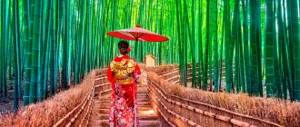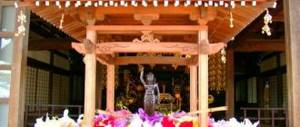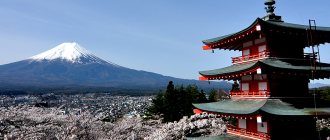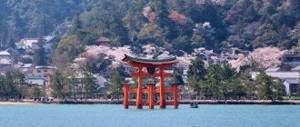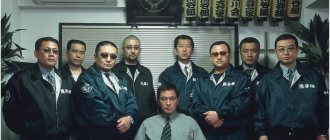Japan is an East Asian island nation washed by the Pacific Ocean. The official name of the country is “Nihon koku” or, alternatively, “Nippon koku”, which translates as “the place where the sun rises”.
Every year, Japan is visited by millions of tourists from all over the world - so, in 2017, their number reached as much as 28.69 million people! This is due to the fact that this is where many beautiful, amazing and impressive places and attractions are located.
Hitsujiyama Park
On the largest island of the Japanese archipelago, Honshu, there is the town of Chichibu (Saitama Prefecture). It is here that you can find one of the most picturesque parks in the country, which is called Hitsujiyama. Its territory is part of the Fuji-Hakone-Izu National Park.
An amazing feature of Khutsizhiyama is that every year from April to May its land turns into a continuous carpet of blooming purple-pink phlox! This herbaceous plant from the Blue family is characterized by strikingly beautiful flowering, which spreads a fragrant fragrant aroma in the air. 17,600 m² become a single colorful canvas, which is complemented by other vegetation - about 1000 sakura, “weeping” cherries and other trees, shrubs and flowers.
Every year the park hosts the Fuji Shibazakura themed festival, dedicated both to the grandiose flowering of plants and the arrival of spring. There really is something to admire here: florists prepare interesting compositions that are created by alternating pink, white, lilac, purple phlox, and decorate the overall appearance of the park to enhance the impression of the landscapes that open to the eye. Hitsuzhiyama is located right at the foot of the Fuji volcano, which reaches a height of 3776 m. There are no other mountains as high in Japan. The park offers inspiring panoramic views - of flowering fields, of the snowy peak of Fuji, of the blue sky...
Tohoku
Nature and panoramas of Tohoku
Tohoku
Occupying the northeastern part of Honshu - Japan's main island - Tohoku is home to some of the most breathtaking scenery in the country. Surrounded by rural scenery, you will find wonderful castles, shrines, samurai residences and hot springs.
In addition to its beautiful rivers, lakes and rugged coastline, Tohoku has many interesting historical and cultural attractions. The samurai houses in Kakunodate, the temples in Hiraizumi and the castle in Hirosaki - the "Kyoto of the North" - are all worth a visit, along with the region's capital, Sendai.
During winter, much of the region is covered in dense snow, so skiing or swimming in the famous Naruko Hot Springs are popular activities. In spring, beautiful cherry blossoms decorate charming towns and villages. For one of Japan's three great views, be sure to head to Matsushima and take in the more than 260 picturesque small islands scattered across the bay.
Sagano Bamboo Forest
Another beautiful place and the real national pride of the Japanese is the Sagano bamboo forest, located in Kyoto Prefecture. Despite the fact that there are city buildings around the park, peace and tranquility reigns on its territory - thousands of thin evergreen plants rise up, and next to them both local residents and visiting tourists leisurely stroll along the paths, alleys and hanging bridges.
The bamboo reserve occupies a very small area of 16 km². However, there is no reason to worry that sooner or later it will be replaced by a metropolis - Sagano is protected by law and is considered an inviolable territory. It is forbidden to go deeper into the forest in the same way as to cut bamboo stems, because all this causes serious harm to the plants.
For those who want to keep a souvenir as a keepsake, there are special shops at the entrance that sell handmade products (dishes, baskets, figurines, etc.).
The bamboo reserve dates back to the 14th century. Then a monk named Muso Soseki, a great connoisseur of poetry and gardening, ordered the creation of a beautiful park from which one could admire the temples and hills of Japan. Today, right next to the Sagano Forest, there is the Zen Buddhist temple complex of Tenryu-ji, which is also a tourist attraction and is even included in the UNESCO World Heritage List due to its architectural value.
This is interesting! Apparently, it was no coincidence that Muso Soseki wanted to build a bamboo park right next to the urban settlement. In Japan, they believe that this evergreen plant can protect people from evil spirits.
The Sagano Nature Reserve is also called the “musical grove.” When the wind blows, amazing sounds arise here - the thin stems begin to emit a peaceful and harmonious rustling. This natural melody is reminiscent of the sound of wind chimes, which are especially popular in the east.
The most popular Japanese cities among tourists
Among Japanese cities there are many popular tourist centers. Traditionally, the average traveler, especially one who visits Japan for the first time, goes to its capital - Tokyo (this is also the largest city), where life is always in full swing, without slowing down. If a tourist is not very interested in sights, but likes active recreation, then you can go to conquer the Sapporo ski resort on the island of Hokkaido. A regular beach holiday in the city of Okinawa is also possible in Japan. The former capital of Kyoto, imbued with the spirit of antiquity, and the port town of Yokohama are also worthy of attention. It is also necessary to mention industrial Osaka with its ultra-modern buildings - a kind of bridge to the future.
Let us characterize the tourist centers in more detail:
- Tokyo. The capital of Japan is a center of diverse cultures. This is where all the key events take place, such as the Matsuri religious festival, the flower viewing festival or the fireworks festival. Exhibitions are regularly updated in numerous museums, and concerts and musicals are held at the venues. There is also a fantastic Disneyland and an ancient antiquities street. Tokyo is not like other Japanese cities. Its main feature is the amazing contrast of giant skyscrapers and ancient architecture with a long history - cozy royal palaces, ancient temples. Life here is vibrant even at night, and the highways are always crowded;
In Tokyo, life does not slow down even at night - Kyoto. The ancient capital of Japan is called the soul of the state, its religious center. This city houses more than two thousand Shinto and Buddhist temples. An attractive atmosphere of antiquity, the splendor of luxurious palaces and the fragrance of blooming gardens reign here. In Kyoto, you can enjoy the sacred ritual of drinking tea in the famous tea house in the company of geishas, while trying to comprehend Japanese philosophy. Some streets in Kyoto are listed as World Heritage Sites;
Kyoto - the cultural capital of Japan - Osaka is an ancient port city with many rivers and canals. Already in the 20th century it turned into a large industrial center. However, the traveler can admire ancient temples and an ancient samurai castle (after restoration, it turned into a museum);
Osaka is an ancient port city with a modern industrial look. - Nara is a city with a deep connection to Buddhism. Many of the temples here are World Heritage Sites. The National Museum houses works of art related to Buddhism. Also in the city you can stroll through the famous park with tame deer;
Nara - a city with a special connection with Buddhism - Matsumoto. The city's charm lies in its historical sites, such as Raven's Castle with its black walls. Japan's favorite artist, Kusama Yayoi, was born here, and her work can be seen in the city's art museum. Matsumoto traditionally hosts music festivals that attract musicians from all over the world;
The charm of Matsumoto lies in its historical sites with ancient architecture, such as the Raven Castle - Sapporo. The city is located on the snowy island of Hokkaido. In addition to being a ski resort, it hosts an annual snow festival at Odori Park with sculpture displays, ice skating and snowball fights. By the way, this is where the Winter Olympic Games took place back in 1972;
Sapporo is a ski resort on the island of Hokkaido, home to the famous snow festival. - Kanazawa. This city is the keeper of traditional culture: Japanese folk crafts (ceramics, lacquerware) and the tea ceremony;
Kanazawa is a city that preserves ancient traditions - crafts and secrets of the tea ceremony - Yokohama. This place is also called the “city of the future.” Here, in addition to skyscrapers, there is a Ferris wheel sparkling with all the colors of the rainbow and a tall lighthouse called the Sea Tower. And in the Chinatown quarter, with its abundance of shops, there is a never-ending holiday.
Yokohama is a Japanese city of the future with ultra-modern buildings
Many cities in Japan are eclectic: they combine architecture from different eras: from ancient to ultra-modern. However, the old and new buildings are somehow subtly connected; in seemingly incompatible things, a striking internal harmony is felt.
Kawagoe
Lovers of antiquity will love the city of Kawagoe (translated from Japanese as “river crossing”), located on the island of Honshu in Saitama Prefecture and having a long history of existence. This settlement appeared back in the 15th century, but its heyday occurred only 200 years after that - it was then that an important dignitary, the head of the shogun’s guard, settled in the city. Kawagoe ceased to be an inconspicuous settlement - a castle with a fortress surrounding it, two-story merchant houses, temples, craft quarters, etc. arose here.
The city burned repeatedly. One of the largest fires occurred here in 1893. However, even despite this, Kawagoe still retains the spirit of old, traditional Japan with its cozy streets and wooden buildings. Every year, this atmosphere is especially intensified on the day of the Kawagoe Festival, which takes place here on the third Saturday and Sunday of October. At this time, an amazing view of the surrounding landscapes opens from the city river.
The main attraction of Kawagoe is the Kita-In Buddhist Temple, built back in 830. Here are furnishings from the old Edo Castle, now known as the "Tokyo Imperial Palace".
After a fire occurred at Edo Castle, entire rooms were actually transported to Kita-In in order to preserve them. These and other objects located on the temple grounds are considered important property of the Japanese prefecture.
Not far from Kita-In there is another interesting place - the Garden of Five Hundred Rakans (Gohyaku Rakan). Despite the name, no vegetation grows here, but there are 538 statues of rakans - disciples of Buddha who achieved enlightenment. Each sculpture is unique, original and inimitable.
Some crayfish, already covered with moss, smile, others look thoughtful, and still others watch the tourists with calm eyes...
Architecture of Japan
In modern Japan there are many buildings erected in a variety of eras - from temples that were created long before the advent of our era, to “high-tech” skyscrapers. Because of this, the cities are very eclectic, but something always subtly unites new and old buildings. A distinctive feature of Japan is that here you can almost always feel inner harmony in the most seemingly incongruous things.
If you want to see Japan through the eyes of the captain of the first Russian voyage around the world, Ivan Krusenstern, who visited it in 1804-1805, you should go to the countryside: real traditional Japanese houses - “minka” - have been preserved as continuous buildings only there.
Hitachi Park
Another of Japan's most beautiful places that is definitely worth visiting is Hitachi National Seaside Park (which means "dawn"), located in Ibaraki Prefecture on the island of Honshu.
Unlike the aforementioned Hutsijiyama, Hitachi occupies a much larger area - as much as 120 hectares! Plants grow on its territory, there is a Luna Park, there are cafeterias and children's play areas, and there is also a zoo where exotic animals live. This is a great place for a solo or group holiday with friends and relatives. The flowering of some plants gives way to the flowering of others, so the riot of colors and aromas in Hitachi does not stop at any time of the year.
And yet, American forget-me-nots, or, by another name, nemophilas, are of particular interest. There are about 4.5 million of these flowers, so they are rightfully considered the real pride of the entire park. Nemophilas bloom from April to May, as a result of which the areas extending beyond the horizon are painted in a delicate blue-blue color. It seems as if the sky itself is temporarily falling to the ground!
Yakushima
Yakushima Island is famous for the atmosphere of antiquity that envelops it. This island is the only one on Earth where trees grow that are over 1000 years old. They say that if you approach the oldest of them, which is approximately 7,000 years old, life will be filled with happiness and peace.
Seiganto-ji Pagoda
The next beautiful place that can introduce a traveler to the culture of Ancient Japan is the Buddhist temple Natishan Seiganto-ji, located in Wakayama Prefecture on the island of Honshu. One of the buildings of this complex was built in the form of a pagoda - a multi-tiered tower, which has a special cult character and sacred meaning. Such a temple is characterized by the presence of cornices, bright decorations, details, etc.
This is interesting! Today Nachisan Seiganto-ji is protected by UNESCO because... considered an important sacred and pilgrimage site. Next to it is another temple, albeit a Shinto one - Hiro-jinja.
The impressive view of the three-tiered crimson pagoda of Seiganto-ji is made even more beautiful by the surrounding landscape - right behind the structure is the country's largest waterfall, Nachi, falling from a cliff 133 m high! Below there is a picturesque swimming pool, which reaches 10 m in depth. You can enjoy the splendor of the entire complex at the Natishan Seiganto-ji observation deck.
The largest number of tourists arrive here on July 14 during the celebration of the Nachi no Ogi Matsuri, a fire festival and one of the most important days in Japan.
The priests carry 12 palanquins and 12 heavy lighted torches along the road to the waterfall, which symbolize the purification of this path. The fiery flame reaches a meter in height. The Japanese themselves consider Nachi Falls to be the embodiment of the sacred spirit of Hiro-gongen.
Kansai
Castle in Osaka. Kansai region. Japan
Nature in the Kansai region. Japan
Kansai is a fascinating region to explore and is the birthplace of Japanese civilization. It boasts three former capitals of the country that showcase Japan's rich and ancient cultural heritage.
In addition to a stunning array of historical and cultural attractions in the form of their many shrines, temples and palaces, the cities of Asuka, Nara and Kyoto are exceptional places to visit. More incredible sights can be seen at Hikone and Himeji Castles and the wonderful hot springs at Arima Onsen.
While the region also boasts vibrant cities such as Osaka and Kobe, Kansai has its share of natural beauty, with Lake Biwa – the largest lake in the country – and Mount Koya being particularly interesting for nature lovers.
Aogashima
Aogashima refers to two geographical objects at once - it is both an island belonging to the Izu cluster and part of the Nampo archipelago, and a volcano that is located here. Under the influence of the warm current, Aogashima established a mild subtropical climate without sudden changes in temperature and unexpected precipitation. The island, which is only 3.5 km long and 2.5 km wide, seems to be a paradise not only for animals, birds and green vegetation, but also for people.
However, this is not entirely true, because the 423 m high stratovolcano located here can pose a real threat to local residents. Although the Aogashima Crater is inactive today, it could theoretically erupt at any time. The last time this happened was in 1783 and 1785. In the first case, the lava destroyed 61 structures and killed 7 people, and in the second case, 140 people already died! After this, the island was abandoned for 50 years, but over time, the inhabitants returned here.
Today people live here as if nothing had happened - they fish, do agricultural work, organize excursions for tourists and underwater fishing enthusiasts. In total, there are about 200 representatives of the local population on Aogashima.
Okinawa
Okinawa Resorts
Beautiful beaches of the Okinawa region
The magnificent Okinawa island chain, stretching towards Taiwan, was the seat of the independent Ryukyu Kingdom until Japan annexed it in 1879. Thus, the charming towns and villages have a different feel with their own cultural identity and customs.
While this certainly makes Okinawa an interesting place to visit, the main reason people come here is for the stunning scenery and world-class beaches. Its many islands - both inhabited and uninhabited - are truly stunningly beautiful. The semi-tropical climate makes it one of the country's most popular tourist destinations among Japanese - and it's easy to see why once you see the idyllic nature there.
The archipelago is also one of the best places in the world for scuba diving. The sparkling waters surrounding the islands are full of attractive corals and teeming with marine life. In addition to this, visitors can enjoy a variety of water sports, with sailing, surfing and fishing being very popular.
Shirakawa village
Connoisseurs of the atmosphere of secluded villages will love the Japanese village of Shirakawa, located in the north of Gifu Prefecture (Honshu Island). This place with a population of 1644 people and an area of 356.55 km² is also included in the UNESCO World Heritage List.
95.7% of the local areas are covered with forests, which become especially striking in the winter season. There is more snow here than anywhere else in Japan!
The height of the snowdrifts can reach 4-5 m. A person who comes here will be able to enjoy the view of the valley with small cozy houses of local residents, as well as the unique and unlike anything else architectural style “gassho-zukuri”, which arose several centuries ago. Firstly, its peculiarity lies in the unusual structure of the thatched roofs - they are connected to the rest of the buildings at an angle of 60 degrees, as if reminiscent of hands folded in prayer. The Japanese saw in this not so much beauty as practical benefit. People needed to build something strong and durable above their heads that would protect them from heavy snow and rain.
This is how the pitched roofs “gassho-zukuri” arose, which did not retain precipitation, but, on the contrary, contributed to its rapid fall to the ground. Secondly, this style involved the abandonment of nails in favor of exclusively natural materials. Despite the fact that ordinary rods were used to connect the beams, this technique proved to be simply excellent - even today houses that are 400 or more years old continue to stand here!
The local population, who live as a united and friendly community, continues to follow these ancient construction methods. People work together to re-thatch roofs and repair buildings because... they do not want to dilute the original architecture of their native village with anything new, modern and high-tech. The residents of Shirakawa live mainly on income from tourism - they offer travelers their homes for overnight stays, and also introduce them to the local culture, traditions and customs.
Kyushu
Nature of Kyushu Island
Nature of Kyushu
Kyushu is the most southwestern main island of Japan. Although it is mostly made up of stunning mountains and fertile valleys, the wide, flat plain to the north is home to its two largest cities, Fukuoka and Kitakyushu. While both cities are worth visiting for their interesting historical sites, museums and architecture, the outstanding beauty of Kyushu is what you'll really want to see.
Indeed, there is a lot of impressive nature on display here. You can visit the world's largest caldera at Aso in one day, surf huge waves at Miyazaki the next, and explore the breathtaking Amakusa island chain in the following days.
One of the main attractions of Kyushu is the famous city of Nagasaki, which was so tragically destroyed by an atomic bomb in World War II. Other attractions include Beppu, a famous hot spring town, and Kumamoto, which has a magnificent castle that you can explore.
Kinkakuji Temple, or Golden Pavilion
The pavilion is a three-story building whose columns, walls and cornices are covered with gold. It was originally built as a residence for a Japanese military ruler named Ashikaga Yoshimitsu, who ruled one of the periods into which Japanese civilization is divided - the Muromachi. After his death, the building became a Buddhist temple.
Although it was set on fire by a young fanatical monk in 1950, the temple was rebuilt on the same site five years later and continued to exist as a repository for various sacred relics.
Hiroshima Peace Memorial Museum
The activities of the memorial museum in Hiroshima, like its twin in Nagasaki, are aimed at preserving the memory of the victims of the atomic bomb attack dropped on the city in August 1945.
The museum's main focus is on calling for the elimination of all nuclear weapons and international peace. A visit to the memorial museum is even part of the general education program in Japanese schools. This museum is included both in the sights of Japan and in the most interesting and unusual museums in the world.
Great Buddha statue in Kamakura
This majestic Buddha statue is located in the Japanese city of Kamakura. It is cast from bronze and weighs about 93 tons, and the height of the statue is more than 13 meters. This makes it the second tallest Buddha statue in Japan, surpassed by the Great Buddha of Kamakura by another nearly 15-meter-tall statue located at Todai-ji Temple in Nara.
Initially, the Great Buddha in Kamakura was made of wood, but in the end it was decided to create a statue of bronze so that it would not be afraid of natural disasters. The bronze Buddha was also located inside a large temple, but the building was destroyed by typhoons and tsunamis, and the statue remained in the open air.
Himeji Castle, or White Heron Castle
The city of Himeji is famous for being home to such an impressive landmark of Japan as this castle. It is located on Himeyama Hill and is a complex of 83 buildings. It received the nickname “Castle of the White Heron” because its sophisticated forms resembled this bird.
Himeji Castle is especially notable for being one of the few Japanese castles that has survived to this day in its original form, having survived wars, fires and earthquakes. It earned even more popularity in the eyes of tourists by repeatedly becoming a location for the filming of many films.
Torii of Itsukushima Shrine
Itsukushima Shrine is a traditional Shinto religious center. This sanctuary has a long history of more than 1400 years. And although the Itsukushima Shrine is the very holy place where services are held, it became famous in Japan and throughout the world thanks to a separate attraction, namely the torii - a large red ritual gate.
They are located in front of the entrance to the sanctuary, right in the bay of the Inland Sea, and are found in the water at high tide. This gate was built here seven years after Shinto was recognized as the official religion of the state. Today, Japanese culture and Shintoism are inseparable. And the torii of the Itsukushima Shrine is an unofficial symbol of the state.
